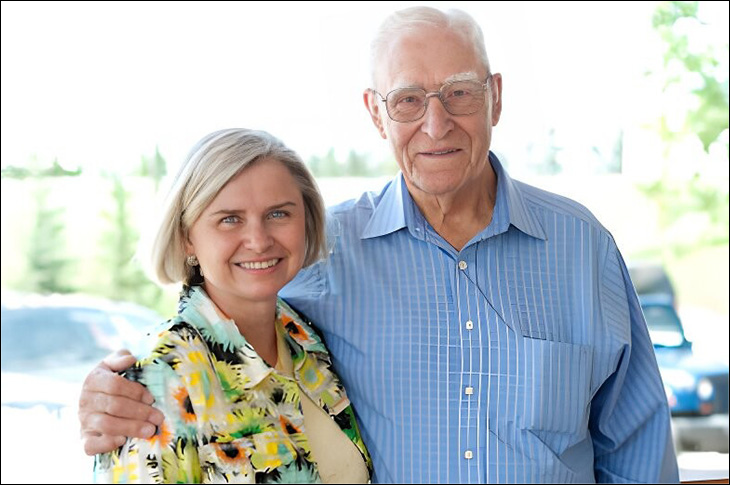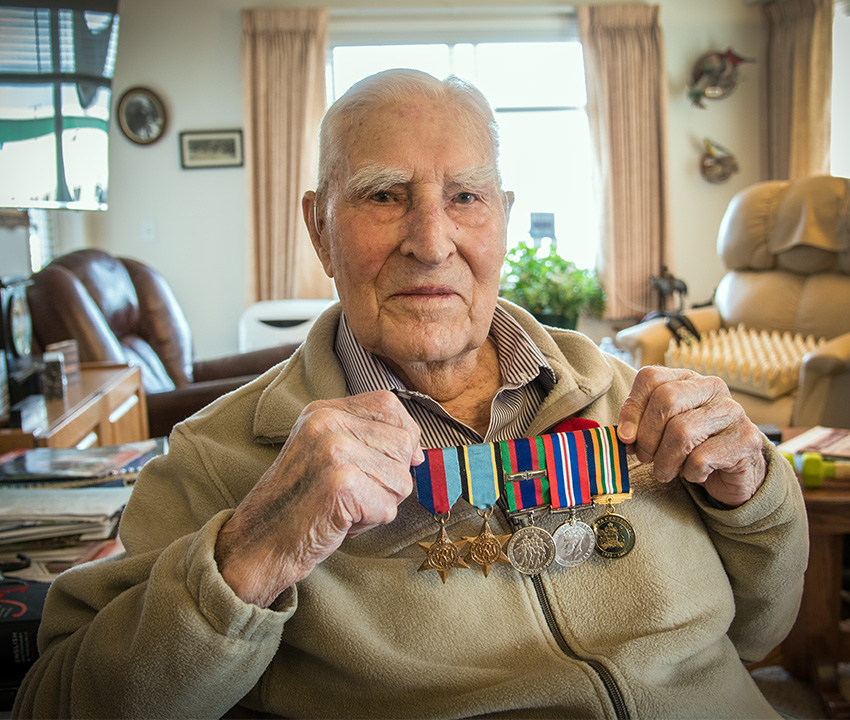A familiar moment of silence and a trumpet sounds to honour the lives of fallen soldiers and stories of war, loss and sacrifice each Remembrance Day. While history of the Second World War has been documented in great detail, many stories are left untold and vanished with the dead.
“You know, over the years, these stories have been missed and been reticent for so long without [veterans] saying them,” says Winston Churchill Parker, 100-year-old rancher, SAIT alumnus and Second World War veteran. “So over the last few years the Legion has been telling us, ‘If you don't tell your stories now, they're gone forever.’”
Saddles and service
Despite his age, Parker carries a physical strength and accounts his life in vivid detail, which is documented in his biography Saddles and Service, written by close friend and fellow SAIT grad, Elaine Thomas Taylor (Journalism ’74).
“Elaine said she'd like to write my life story and I hummed and hawed, but finally we decided to do it,” Parker explains. “I couldn't get my heart into it. I didn't treat her very good in the first few months because I just couldn’t get to work on it.
I didn't think my stories were worth telling,” he says. “Too many people have better stories than me.”
Parker was already 94-years-old when the book was published in 2011, a story that accounts his childhood, his service in the Second World War and his life as a rancher afterward. Parker and Thomas set up an endowment fund at SAIT financed by the proceeds of the book to support the Saddles and Service student award. Their endowment just reached $30,000 this year.
Parker says the decision was made to support SAIT students because of their shared history with the institute.
 Pictured above:
Elaine Thomas Taylor and Winston Parker
Pictured above:
Elaine Thomas Taylor and Winston Parker
From Tech to war
As a teen, Parker studied in the Tractor program at SAIT, then called the Provincial Institute of Technology and Art (PITA) and referred to by many as Tech.
“I was born and raised at the time when everybody was sharp on horses and suddenly they started switching to tractors, and most of our fathers couldn't tell you how to adjust anything on a tractor. I knew nothing about internal combustion engines, so I went to SAIT and that was a great help. I met some fellas and we became friends and now I'm the last one left.”
Parker graduated from PITA in 1939, the same year Britain and France declared war on Germany. He and his childhood friend Bill Wallace enlisted in the Royal Canadian Air Force (RCAF), hoping to follow in the footsteps of their idol Wilfrid Reid “Wop” May, who flew in the First World War.
“Wop was a friend of ours, I had known him since I was a kid and he’s one of the great heroes of Canada, so I was quite intrigued by this great ace. A kid is really influenced by that,” Parker says.
As part of his training, Parker spent three months at the No. 2 Wireless School ― one of four schools set up by the British Commonwealth Air Training Plan in Canada ― which was housed on the PITA campus, before attending bombing and gunnery school.
Missing in action
He was sent overseas June 1941, where he was declared missing in action after his plane was hit by German fighters. Parker had been caught and spent three years as a prisoner of war (POW) in Stalag VIIIB, documented as one of the harshest prison camps of the war. Parker was then traipsed about 1,000 kms alongside thousands of prisoners in a march that is documented in his book as the longest and cruelest march in the history of the Second World War.
“We were down to desperate and we were dying every day. I'm one of the lucky ones. I made it.”
Overcoming great loss
After being liberated by the Americans, Parker returned home and bought a ranch. He later took a photography course at SAIT, a hobby he continues to enjoy and talks about with great enthusiasm.
It seems Parker’s pursuit of a generous and passionate life has allowed him to thrive in spite of challenging memories and great loss.
“I haven't lived the war over and over again like so many people. I came home and became a rancher and that's what I liked and loved doing. The war was put in the background as much as I could. But I thought of the fellas.
“There's so many of our friends who didn't make it, and they paid for their lives, so that we have the freedom we’ve got. I used to talk at the schools and, one day they asked me, ‘What do you think of when it’s Remembrance Day?’ I said, ‘One thing I remember is when prisoners died out there in Germany in the prison camp ― they’d have a funeral on a cold miserable evening, you’d be out there in the woods, the Last Post [was played and it] sounded so lonely ― I think of that. And the other thing I think of is my friends, two crew members who got killed, and I can’t help but think, ‘Why am I here, but they’re not.”
This Remembrance Day, Parker is scheduled to lay a wreath at a memorial service in Okotoks, where he lives. At his age, he takes life day-by-day, but says, if he is feeling well, he will be there to honour those who fought with him.
Saddles and Service can be purchased online, with proceeds supporting SAIT students.
After Britain and France declared war on Germany in 1939, Winston Parker (Tractor '39) enlisted in the Royal Canadian Air Force (RCAF). Parker turned 100 years old in July 2018. His life story is documented in "Saddles and Service: Winston Parker's Story," written by SAIT grad Elaine Taylor Thomas (Journalism '74).

Oki, Âba wathtech, Danit'ada, Tawnshi, Hello.
SAIT is located on the traditional territories of the Niitsitapi (Blackfoot) and the people of Treaty 7 which includes the Siksika, the Piikani, the Kainai, the Tsuut’ina and the Îyârhe Nakoda of Bearspaw, Chiniki and Goodstoney.
We are situated in an area the Blackfoot tribes traditionally called Moh’kinsstis, where the Bow River meets the Elbow River. We now call it the city of Calgary, which is also home to the Métis Nation of Alberta.
